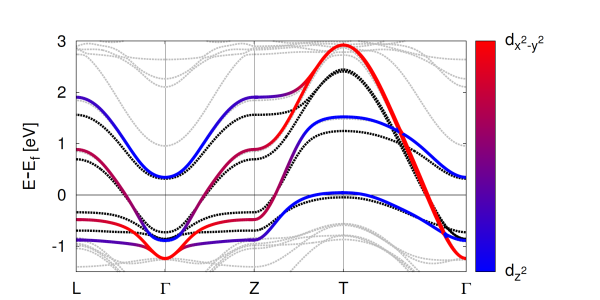An in-depth look at a high-temperature superconducting nickelate
By Nicola Nosengo - NCCR MARVEL
The recent discovery of superconductivity in La3Ni2O7, the bi-layer version of the nickelates family, has caused excitement among material scientists. Its critical temperature, the threshold above which superconductivity manifests, is around 80 K, significantly higher than for infinite-layer nickelates - and when it comes to superconductivity the higher the temperature the better, because it means that the properties of the material are easier to control and exploit.
“The experimental discovery was quite a surprise," says Philipp Werner, physics professor at the University of Fribourg and a member of MARVEL’s “Advanced Simulation Methods” project. “Because of the similarities to cuprates [copper based high-temperature superconductors], people have been trying to synthesise nickel-based superconductors for many years, but the critical temperature remained disappointingly low. Also, superconductivity was only found in thin films of the hard-to-synthesize infinite layer compounds, and it wasn't clear why the bulk materials were not superconducting. The big breakthrough here is that the bi-layer system is easy to synthesise, is a bulk system, and has a much higher critical temperature. The downside is that superconductivity in this system appears under high pressure”
The Nature paper introducing the superconductor included DFT calculations of its high-pressure phase, but a more advanced description of the material’s electronic structure was lacking. “Such a strongly correlated system cannot be properly described with standard DFT approaches,” explains Viktor Christiansson, a PhD student in Werner’s group and first author of a new study just published in Physical Review Letters, that makes significant advancements in the theoretical description of the correlated electron state.

The model band structure (solid lines) of La3Ni2O7 plotted ontop of the DFT band structure (gray dashed lines). The color bar shows the orbital character of the model bands. Christiansson V., Petocchi F., and Werner P., Physical Review Letters (2023).
The study employs various advanced many body techniques to present different levels of description of the material: the techniques include well-established approaches like GW and dynamical mean field theory (DMFT), as well as more recently developed methods like extended DMFT (EDMFT) and GW+EDMFT. The latter technique corresponds to the highest level of description, is free of adjustable parameters, and captures the long-ranged nature of the Coulomb interaction. It’s a method developed by Werner’s group within MARVEL over the last ten years, and this study is one of its first major applications. “What is nice is that the experimental discovery is very recent, and we were able to produce meaningful ab initio results in a few weeks, which shows that the GW+EDMFT method is now at a stage where it can be applied efficiently,” says Werner.
The use of this technique paints a more complex picture of the electronic state than DFT calculations and brings some surprises. One of the main ones is that when nonlocal Coulomb interactions are taken into account with GW+EDMFT, a charge-order instability appears. This is compatible with experimental data for the low-pressure phase, but it’s quite surprising to still find a charge order tendency in the high-pressure one, the researchers explain.
“For some reason that is not yet captured in this model, this instability must be suppressed in the high-pressure phase, otherwise you would not expect superconductivity”, says Werner. ”We speculate that it could be due to charge transfer from bands that we did not include in the model, since the ordering tendency is suppressed with doping. Also, very recently there was a new experimental analysis of the bi-layer nickelate that revealed that its structure was not correctly described in the Nature paper. Our preliminary analysis indicates that the newly proposed structure could also explain the suppression of charge order.
Another important finding of the paper, which had not emerged from the DFT calculations, is the main role of the dz2 orbital in the electronic structure of the material. “It's interesting because it's very different from what you see in cuprates. Initially, these nickelates were thought to be analogues of cuprates, which is why people started looking into them,” says Werner. “In cuprates the dx2−y2 orbital is the relevant one, also for superconductivity. Here we found that the dz2 orbital, which is partially filled and strongly correlated, is the relevant player. This would make this material even more interesting, because it would be a high-temperature superconductor with a potentially different superconducting mechanism than in cuprates”.
The group plans to continue theoretical investigations of this material. “Once the low-energy description is fully established, one wants to study pairing tendencies to understand which pairing channel dominates, and to understand how different from cuprates these systems really are” says Christiansson. “We would also like to take into account more bands,” adds Werner. “What we presented here was the smallest possible model space, and it would be nice to increase it. But this will make the calculations much heavier and we’ll have to see how many more bands we can really handle”.
Reference
Christiansson V., Petocchi F., and Werner P., "Correlated Electronic Structure of La3Ni2O7 under Pressure", Physical Review Letters 131, 206501 (2023) DOI: https://doi.org/10.1103/PhysRevLett.131.206501
Low-volume newsletters, targeted to the scientific and industrial communities.
Subscribe to our newsletter